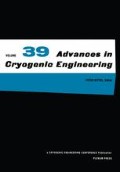Abstract
High Reynolds number cryogenic nitrogen tunnels usually have considerable mass of structural metal within the insulated test environment. Prior to high Reynolds number aerodynamic testing, this internal structure is cooled from ambient temperature to 120K using liquid nitrogen. This paper studies the structural cooldown as a problem of optimizing liquid nitrogen consumption and time for the U.S National Transonic Facility. A simple model of the tunnel thermodynamic process is used to study the optimization and cooldown strategies via nonlinear dynamical simulation.
Access this chapter
Tax calculation will be finalised at checkout
Purchases are for personal use only
Preview
Unable to display preview. Download preview PDF.
References
W.E.Bruce, D.E.Fuller, and W.B.Igoe, The National Transonic Facility shakedown test results and calibration plans, AIAA 84-0584, Aerodynamic testing conf (1984).
W.E.Bruce, and B.B Gloss, The U.S National Transonic Facility, Special course in cryogenic wind tunnel technology, von Karman Inst, AGARD 774-R (1989).
S.Balakrishna, Synthesis of a control model for a liquid nitrogen cooled closed circuit nitrogen wind tunnel and its validation, NASA CR-162508 (1980).
S.Balakrishna, W.A.Kilgore, and J.J. Thibodeaux, Control of large cryogenic tunnels, AIAA CP 92-3930, Aerospace ground testing conference (1992).
H. Elmquist, K.J.Astrom, T.Sconthal, and W. Wittenmark, “Users guide to SIMNON”. SSPA Systems (1990).
S. Balakrishna, W.A.Kilgore, Microcomputer based controller for the NASA Langley 0.3-m Transonic Cryogenic wind Tunnel, NASA CR-181308 (1989).
Author information
Authors and Affiliations
Editor information
Editors and Affiliations
Rights and permissions
Copyright information
© 1994 Springer Science+Business Media New York
About this chapter
Cite this chapter
Balakrishna, S., Kilgore, W.A. (1994). Structural Cooldown Energy Optimization for Cryogenic Wind Tunnels. In: Kittel, P. (eds) Advances in Cryogenic Engineering. Advances in Cryogenic Engineering, vol 39. Springer, Boston, MA. https://doi.org/10.1007/978-1-4615-2522-6_12
Download citation
DOI: https://doi.org/10.1007/978-1-4615-2522-6_12
Publisher Name: Springer, Boston, MA
Print ISBN: 978-1-4613-6074-2
Online ISBN: 978-1-4615-2522-6
eBook Packages: Springer Book Archive

